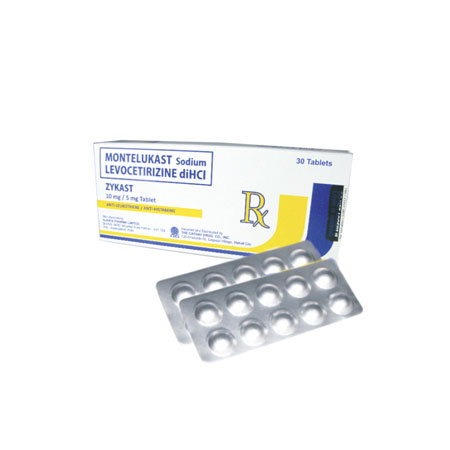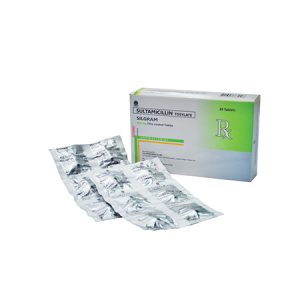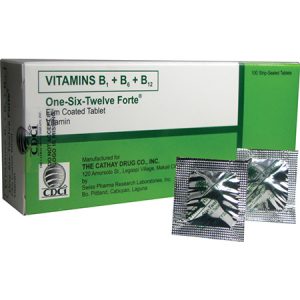Description
The Cathay Drug Co., Inc.
FORMULATION
Each tablet contains:
Montelukast (as sodium) 10 mg
Levocetirizine (as hydrochloride) 5 mg
PHARMACOLOGY
Montelukast
The cysteinyl leukotrienes (LTC4, LTD4, LTE4) are potent inflammatory eicosanoids released from various cells including mast cells and eosinophils. These important mediators bind to cysteinyl leukotriene receptors. Cysteinyl leukotriene have been correlated with the pathphysiology of asthma and allergic rhinitis. In asthma, leukotriene mediated effects include bronchoconstriction, mucuos secretion, vascular permeability and eosinophil recruitment. In allergic rhinitis, cysteinyl leukotrienes are released from nasal mucosa after allergen exposure during both early- and late-phase reactions and are associated with symptoms of allergic rhinitis. Intranasal challenge with cysteinyl leukotrienes has been shown to increase nasal airway resistance and symptoms of nasal obstruction. Montelukast is an orally active compound which binds with high affinity and selectively to the cysteinyl leukotriene type 1 receptor thereby preventing cysteinyl leukotriene from exerting their effects.
Levocetirizine
Levocetirizinem the active enantiomer of cetirizine, is an antihistamine. Its principal effects are mediated via selective inhibition of H1 receptors. The antihistamine activity of Levocetirizine has been documented in a variety of animal and human models.
PHARMACOKINETICS
Montelukast
Absroption
Montelukast is rapidly absorbed following oral administration. Mean peak plasma concentration (Cmax) is achieved 3 hours (Tmax) after administration of a 10 mg dose in adults in the fasted state. The mean oral bioavailability is 64%. The oral; bioavailability and (Cmax) are not influenced by a standard meal. Safety and efficacy were demonstrated in clinical trials where the 10 mg film-coated tablet was administered without regard to the timing of food ingestion. Cmax is achieved in 2 hours after administration of the 5 mg chewable tablet in adults in the fasted state. The mean oral bioavailability is 73% and is decreased to 63% by a standard meal.
Distribution
Montelukast is more than 99% bound to plasma proteins. Steady state volume of distribution of Montelukast averages 8-11 liters. Studies in rats with radio labeled Montelukast indicate minimal distribution across the blood-brain barrier. In addition, concentrations of radio labeled material at 234 hours post dose were minimal in all other tissues.
Metabolism
Montelukast is extensively metabolized. In studies with therapeutic doses, plasma concentrations of metabolites of Montelukast are undetected at steady state in adults and children. In vitro studies using human liver microsomes indicate that cytochrome P450 3A4, 2A6 and 2C9 are involved in the metabolism of Montelukast.
Based on further in vitro results in human liver microsomes, therapeutic plasma concentrations of Montelukast do not inhibit cytochrome P450 3A4, 2C9 1A2, 2A6, 2C10 or 2D6. The contribution of metabolites to the therapeutic effect of Montelukast is minimal.
Elimination
The plasma clearance of Montelukast averages 45 mL/min in healthy adults. Following an oral dose of radio labeled Montelukast, 86% of the radioactivity was recovered in 5-day fecal collections and 0.2% was recovered in urine. Coupled with estimates of Montelukast oral bioavailability, this indicates than Montelukast and its metabolites are excreted almost exclusively via the bile.
Elderly
The phramcokinetic profile and the oral bioavailability of a single 10 mg oral dose of Montelukast are similar in elderly and younger adults. The plasma half-life of Montelukast is slightly longer in the elderly. Due to the Levocetirizine component of Montelukast plus Levocetirizine however, dosage adjustment may be required in elderly patients (See Dosage and Administration – Elderly).
Patients with Renal Impairement
Since Montelukast and its metabolites are not excreted in the urine, the pharamacokinetics of Montelukast was not evaluated in patients with renal insufficiency. Due to the Levocetirizine component of MONTELUKAST PLUS LEVOCETIRIZINE however, dosage adjustment is required in patients with renal impairement (See Dosage and Administration – Patients with Renal Impairment).
Patients with Hepatic Impairment
Patients with mild to moderate hepatic insufficiency and clinical evidence of cirrhosis had evidence of decreased metabolism of Montelukast resulting in 41% (90% Cl=7%, 85%) higher mean Montelukast area under the plasma concentration curve (AUC) following a single 10 mg dose. The elimination of Montelukast was slightly prolonged compared with that in healthy subjects (mean half-life, 7.4 hours). No dosage adjustment is required in patients with mild to moderate hepatic insufficiency. The pharmacokinetics of Montelukast in patients with more severe hepatic impairment or with hepatitis has not been evaluated.
Levocetirizine
Absorption
Levocetirizine is rapidly and extensively absorbed following oral administration. Peak plasma concentrations are achieved 0.9 h after dosing. Steady state is achieved after two days. Peak concentrations are 270 mg/mL and 308 mg/mL following a single and repeated 5 mg dose once daily, respectively. The extent of absorption is dose-independent and is not altered by food, but the peak concentration is reduced and delayed.
Distribution
No tissue distribution data are available in humans, neither concerning the passage of Levocetirizine through the blood-brain barrier. In rats and dogs, the highest tissue levels are found in liver and kidneys, the lowest in the CNS compartment. Levocetirizine is 90% bound to plasma proteins. The distribution of Levocetirizine is restrictive, as the volume of distribution is 0.4 l/kg.
Metabolism
The extent of metabolism of Levocetirizine in humans is less than 14% of the dose and therefore differences resulting from genetic polymorphism or concomitant intake of enzyme inhibitors are expected to be negligible. Metabolic pathways include aromatic oxidation, N- and O- dealkylation and taurine conjugation. Dealkylation pathways are primarily mediated by CYP 3A4 while aromatic oxidation involved multiple and/or unidentified CYP isoforms. Levocetirizine had no effect on the activities of CYP isoenzymes 1A2, 2C9, 2C19, 2D6, 2E1 and 3A4 at concentrations well above peak concentrations achieved following a 5 mg oral dose. Due to its low metabolism and absence of metabolic inhibition potential, the interaction of Levocetirizine with other substances, or vice-versa, is unlikely.
Elimination
The plasma half-life in adults is ± 1.9 hours. The mean apparent total body clearance is 0.63 mL/min/kg. The major route of excretion of Levocetirizine and metabolites is via urine, accounting for a mean of 85.4% of the dose. Excretion via feces accounts for only 12.9% of the dose. Levocetirizine is excreted both by glomerular filtration and active tubular secretion.
Elderly
Limited pharmacokinetic data is available in elderly subjects. Following once daily repeated oral administration of 30 mg Levocetirizine for 6 days in 9 elderly subjects (74 – 75 years of age), the total body clearance was approximately 33% lower compared to that in younger adults. The disposition of racemic cetirizine has been shown to be dependent on renal function rather than age. Therefore, the dosage of Levocetirizine should be adjusted in accordance with renal function in elderly patients.
Patients with Renal Impairment
The apparent body clearance of Levocetirizine is correlated to the creatinine clearance. It is therefore recommended to adjust the dosage and frequency of dosage of Levocetirizine, based on creatinine clearance in patients with moderate and severe renal impairment.
Patients with Hepatic Impairment
Levocetirizine has not been studied in patients with hepatic impairment. The non-renal clearance (indicative of hepatic contribution) was found to constitute about 28% of the total body clearance in healthy adult subjects after oral administration. As Levocetirizine is mainly excreted unchanged by the kidney, it is unlikely that the clearance of Levocetirizine is significantly decreased in patients solely with hepatic impairment.
INDICATIONS
Montelukast plus Levocetirizine is indicated for the relief of symptoms associated with seasonal and perennial allergic rhinitis.
CONTRAINDICATIONS
Montelukast plus Levocetirizine is contraindicated in patients with known hypersensitivity to Montelukast or Levocetirizine, patients with severe (creatinine clearance less than 10 mL/min) or hepatic impairment, in children 6-11 years of age with renal impairment, and women who are pregnant or breastfeeding.
DOSAGE AND ADMINISTRATION
Adults
One tablet containing Montelukast 10 mg plus Levocetirizine 5 mg once daily. Or as prescribed by the physician.
Elderly
Dosages in the elderly should be adjusted in accordance with their renal function (see Dosage and Administration – Patient with Renal Impairment).
Patients with Renal Impairment
In adults and children 12 years of age and older with:
- Mild renal impairment (ClCr 50-80 mL/min): one tablet containing Montelukast 10 mg plus Levocetirizine 2.5 mg once daily.
- Moderate renal impairment (ClCr 30-50 mL/min): one tablet containing Montelukast 10 mg plus Levocetirizine 2.5 mg once daily, every other day.
Patients with Hepatic Disease
No dosage adjustment is needed in patients solely with mild to moderate hepatic impairment. Usage is not recommended in patients with severe hepatic impairment.
Children and Adolescent
Children aged 15+: one tablet containing 10 mg Montelukast and Levocetirizine 5 mg once daily.
Or as prescribed by the physician.
SPECIAL WARNING AND PRECAUTIONS FOR USE
Levocetirizine
The administration of Levocetirizine to infants and toddlers aged less than 2 years is not recommended. Therefore the use of MONTELUKAST PLUS LEVOCETIRIZINE is not recommended to infants and toddlers less than 2 years of age. In sensitive patients the simultaneous administration of cetirizine or Levocetirizine and alcohol or other CNS depressants may have effects on the central nervous system, although it has been shown that the racemate cetirizine does not potentiate the effect of alcohol. Comparative clinical trials have revealed no evidence that Levocetirizine at the recommended dose impairs mental alertness, reactivity or the ability to drive. Nevertheless, some patients do experience somnolence, fatigue and asthenia under therapy with Levocetirizine. Therefore, patients intending to drive, engage in potentially hazardous activities or operate machinery should take their response to the medicinal product into account.
DRUG INTERACTIONS
Montelukast
In drug interactions studies, the recommended clinical dose of Montelukast did not have clinically important effects on the pharmacokinetics of the following drugs: theophylline, prednisone, prednisolone, oral contraceptives (ethinyl estradiol/norethindrone 35/1), terfenadine, digoxin and warfarin. The area under the plasma concentration curve (AUC) for Montelukast was decreased approximately 40% in subjects with co-administration of phenobarbital. Since Montelukast is metabolized by CYP 3A4, caution should be exercised, particularly in children, when Montelukast is coadministered with inducers of CYP 3A4 such as phenytoin, phenobarbital and rifampicin. In vitro studies have shown than Montelukast is a potent inhibitor of CYP 2C8. However, data from a clinical drug-drug interaction study involving Montelukast and risoglitazone (a probe substrate representative of drugs primarily metabolized by CYP 2C8) demonstrated that Montelukast does not inhibit CYP 2C8 in vivo. Therefore, Montelukast is not anticipated to markedly alter after the metabolism of drugs metabolized by this enzyme (e.g., paclitaxel, risoglitazone and repaglinide).
Levocetirizine
In vitro data indicate that Levocetirizine is unlikely to produce pharmacokinetic interactions through inhibition or induction of liver drug-metabolizing enzymes. Mo in-vivo drug-drug interaction studies have been performed with Levocetirizine. In pharmacokinetic interaction studies performed with racemic cetirizine, cetirizine did not interact with antripyrine, pseudoephedrine, erythromycin, azithromycin, ketoconazole or cimetidine. A small decrease in the clearance of cetirizine was caused by a 400 mg dose of theophylline. Ritonavir increased the plasma AUC, half-life and decreased the clearance 42%, 53% and 29% respectively. The disposition of retinovir was not altered by administration of cetirizine.
ADVERESE EFFECT
Montelukast
Montelukast has been evaluated for safety in approximately 2950 adult and adolescent patients 15 years of age and older in clinical trials. In placebo-controlled clinical trials, the following adverse experiences reported with Montelukast (M) occurred in greater than or equal to 1% of patients and at an incidence greater than that in patients treated with placebo (P), regardless of causality assessment; Body As A Whole; Asthenia/ fatigue M (1.8%), P (1.2%). Fever: M (0.6%), P (3.0%). Abdominal pain: M (2.9%), P (2.5%). Trauma: M (1.0%), P (0.8%). Digestive System Disorders; Dyspepsia M (2.1%), P (1.1%). Infectious gastroenteritis: M (2.1%), P (1.1%). Dental Pain: M (1.7%), P (1.0%). Nervous System/ Psychiatric: Dizziness M (1.9%), P (1.4%). Headache: M (18.4%), P (18.1%). Respiratory System Disorder: Congestion, nasal M (1.6%), P (1.3%). Cough M (2.7%), P (2.4%). Influenza: M (4.2%), P (3.9%). Skin/ Skin Appendages Disorder; Rash M (1.6%), P (1.2%). Laboratory Adverse Experiences; ALT increased M (2.1%), P (2.0%). AST increased M (1.6%), P (1.2%). Pyuria: M (1.0%), P (0.9%).
Levocetirizine
In therapeutic studies in women and men aged 12 to 71 years, 15.1% of the patients in the Levocetirizine 5 mg group had at least one adverse drug reactions compared to 11.3% in the placebo group. 91.6% of these adverse drug reactions were mild to moderate.
In therapeutic trials, the drop out rate due to adverse events was 1.0% (9/935) with Levocetirizine 5 mg and 1.8% (14/771) with placebo. Clinical therapeutic trials with Levocetirizine included 935 subjects exposed to the drug at the recommended dose of 5 mg daily. From this date, the following adverse drug reactions were reported at rates of 1% or greater during treatment with Levocetirizine 5 mg (L) or placebo (P); Headache; L (2.6%), P (3.2%). Somnolence: L (5.2%), P (1.4%). Dry mouth: L (2.6%), P (1.6%). Fatigue: L (2.5%), P (1.2%). Further uncommon incidences of adverse reaction like asthenia or abdominal pain were observed. The incidence of sedating adverse drug reaction such as somnolence, fatigue and asthenia was altogether more common (8.1%) with Levocetirizine 5 mg than with placebo (3.1%). In addition to the adverse reactions reported during clinical studies and listed above, very rare cases of the following adverse reactions have been reported in post-marketing experience:
- Immune system disorders: hypersensitivity including anaphylaxis.
- Psychiatric disorders: aggression, agitation.
- Nervous system disorders:
- Eye disorders: visual disturbances.
- Cardiac disorders:
- Respiratory, thoracic and mediastinal disorders:
- Gastrointestinal disorders:
- Hepatobillary disorders:
- Skin and subcutaneous disorders: angioneurotic edema, fixed drug eruption, pruritus, rash, urticarial.
- Musculoskeletal, connective tissues, and bone disorders:
- Investigations: weight gain, abnormal liver function tests.
USE IN PREGNANCY AND LACTATION
No well controlled trials have been performed with either Montelukast or Levocetirizine in women who are pregnant. Therefore, use of MONTELUKAST PLUS LEVOCETIRIZINE is not recommended in women who are pregnant. It is not known whether Montelukast or Levocetirizne are excreted in breast milk. Therefore, use of MONTELUKAST PLUS LEVOCETIRIZINE is not recommended in women who are breastfeeding.
CAUTION
Foods, Drugs, Devices and Cosmetics Act prohibits dispensing without prescription.
STORE AT TEMPERATURES NOT EXCEEDING 30°C.
PTOTECT FROM LIGHT.
AVAILABILITY
Montelukast sodium + Levocetirizine hydrochloride (Zykast) 10 mg/ 5 mg Tablet x Alu-alu blister pack of 10’s, box of 30 tablets.
Manufactured by
Ajanta Pharma Limited
B-4/5/6, MIDC Industrial Area Paithan – 431 128
Dist-Aurangabad, India
Imported and Distributed by
The Cathay Drug Co., Inc.
2nd Floor Vernida 1 Condominium
120 Amorsolo St., Legaspi Village, Makati City
Date of revision: July 2016






Reviews
There are no reviews yet.